
LLMRec
[WSDM'2024 Oral] "LLMRec: Large Language Models with Graph Augmentation for Recommendation"
Stars: 269
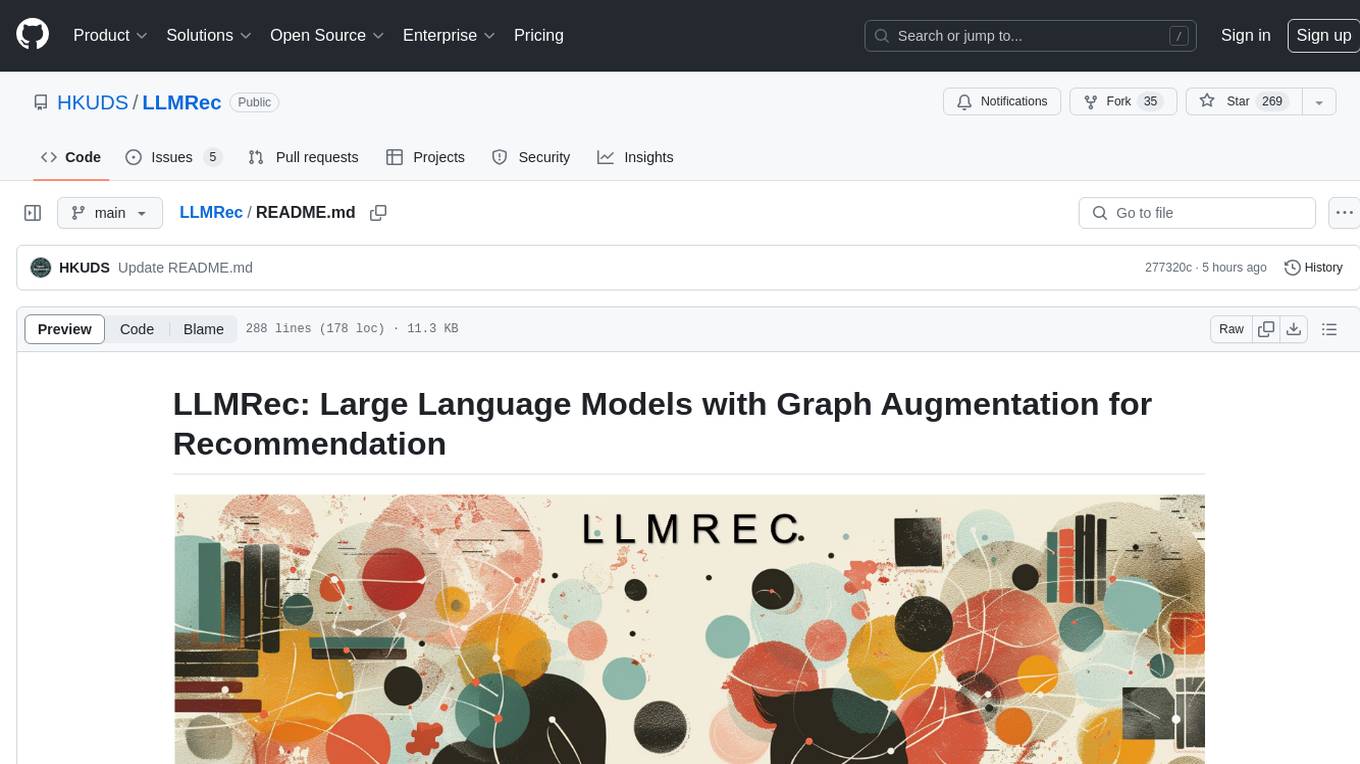
LLMRec is a PyTorch implementation for the WSDM 2024 paper 'Large Language Models with Graph Augmentation for Recommendation'. It is a novel framework that enhances recommenders by applying LLM-based graph augmentation strategies to recommendation systems. The tool aims to make the most of content within online platforms to augment interaction graphs by reinforcing u-i interactive edges, enhancing item node attributes, and conducting user node profiling from a natural language perspective.
README:
PyTorch implementation for WSDM 2024 paper LLMRec: Large Language Models with Graph Augmentation for Recommendation.
Wei Wei, Xubin Ren, Jiabin Tang, Qingyong Wang, Lixin Su, Suqi Cheng, Junfeng Wang, Dawei Yin and Chao Huang*. (*Correspondence)
Data Intelligence Lab@University of Hong Kong, Baidu Inc.
This repository hosts the code, original data and augmented data of LLMRec.
LLMRec is a novel framework that enhances recommenders by applying three simple yet effective LLM-based graph augmentation strategies to recommendation system. LLMRec is to make the most of the content within online platforms (e.g., Netflix, MovieLens) to augment interaction graph by i) reinforcing u-i interactive edges, ii) enhancing item node attributes, and iii) conducting user node profiling, intuitively from the natural language perspective.
-
[x] [2024.3.20] 🚀🚀 📢📢📢📢🌹🔥🔥🚀🚀 Because baselines
LATTICEandMMSSLrequire some minor modifications, we provide code that can be easily run by simply modifying the dataset path. -
[x] [2023.11.3] 🚀🚀 Release the script for constructing the prompt.
-
[x] [2023.11.1] 🔥🔥 Release the multi-modal datasets (Netflix, MovieLens), including textual data and visual data.
-
[x] [2023.11.1] 🚀🚀 Release LLM-augmented textual data(by gpt-3.5-turbo-0613), and LLM-augmented embedding(by text-embedding-ada-002).
-
[x] [2023.10.28] 🔥🔥 The full paper of our LLMRec is available at LLMRec: Large Language Models with Graph Augmentation for Recommendation.
-
[x] [2023.10.28] 🚀🚀 Release the code of LLMRec.
- [ ] Provide different larger version of the datasets.
- [ ] ...
pip install -r requirements.txt
cd LLMRec/LLM_augmentation/
python ./gpt_ui_aug.py
python ./gpt_user_profiling.py
python ./gpt_i_attribute_generate_aug.py
cd LLMRec/
python ./main.py --dataset {DATASET}
Supported datasets: netflix, movielens
Specific code execution example on 'netflix':
# LLMRec
python ./main.py
# w/o-u-i
python ./main.py --aug_sample_rate=0.0
# w/o-u
python ./main.py --user_cat_rate=0
# w/o-u&i
python ./main.py --user_cat_rate=0 --item_cat_rate=0
# w/o-prune
python ./main.py --prune_loss_drop_rate=0
├─ LLMRec/
├── data/
├── netflix/
...
We collected a multi-modal dataset using the original Netflix Prize Data released on the Kaggle website. The data format is directly compatible with state-of-the-art multi-modal recommendation models like LLMRec, MMSSL, LATTICE, MICRO, and others, without requiring any additional data preprocessing.
Textual Modality: We have released the item information curated from the original dataset in the "item_attribute.csv" file. Additionally, we have incorporated textual information enhanced by LLM into the "augmented_item_attribute_agg.csv" file. (The following three images represent (1) information about Netflix as described on the Kaggle website, (2) textual information from the original Netflix Prize Data, and (3) textual information augmented by LLMs.)
Visual Modality: We have released the visual information obtained from web crawling in the "Netflix_Posters" folder. (The following image displays the poster acquired by web crawling using item information from the Netflix Prize Data.)
🚀🚀 We provide the processed data (i.e., CF training data & basic user-item interactions, original multi-modal data including images and text of items, encoded visual/textual features and LLM-augmented text/embeddings). 🌹 We hope to contribute to our community and facilitate your research 🚀🚀 ~
-
netflix: Google Drive Netflix. 🌟(Image&Text)
We use CLIP-ViT and Sentence-BERT separately as encoders for visual side information and textual side information.
Prompt
Recommend user with movies based on user history that each movie with title, year, genre. History: [332] Heart and Souls (1993), Comedy|Fantasy [364] Men with Brooms(2002), Comedy|Drama|Romance Candidate: [121]The Vampire Lovers (1970), Horror [155] Billabong Odyssey (2003),Documentary [248]The Invisible Guest 2016, Crime, Drama, Mystery Output index of user's favorite and dislike movie from candidate.Please just give the index in [].
Completion
248 121
Prompt
Generate user profile based on the history of user, that each movie with title, year, genre. History: [332] Heart and Souls (1993), Comedy|Fantasy [364] Men with Brooms (2002), Comedy|Drama|Romance Please output the following infomation of user, output format: {age: , gender: , liked genre: , disliked genre: , liked directors: , country: , language: }
Completion
{age: 50, gender: female, liked genre: Comedy|Fantasy, Comedy|Drama|Romance, disliked genre: Thriller, Horror, liked directors: Ron Underwood, country: Canada, United States, language: English}
Prompt
Provide the inquired information of the given movie. [332] Heart and Souls (1993), Comedy|Fantasy The inquired information is: director, country, language. And please output them in form of: director, country, language
For each user, 0 represents a positive sample, and 1 represents a negative sample. For each user, the dictionary stores augmented information such as 'age,' 'gender,' 'liked genre,' 'disliked genre,' 'liked directors,' 'country,' and 'language.'Completion
Ron Underwood, USA, English
For each item, the dictionary stores augmented information such as 'director,' 'country,' and 'language.'
step 1: select base model such as MMSSL or LATTICE
step 2: obtain user embedding and item embedding
step 3: generate candidate
_, candidate_indices = torch.topk(torch.mm(G_ua_embeddings, G_ia_embeddings.T), k=10)
pickle.dump(candidate_indices.cpu(), open('./data/' + args.datasets + '/candidate_indices','wb'))
Example of specific candidate data.
In [3]: candidate_indices
Out[3]:
tensor([[ 9765, 2930, 6646, ..., 11513, 12747, 13503],
[ 3665, 8999, 2587, ..., 1559, 2975, 3759],
[ 2266, 8999, 1559, ..., 8639, 465, 8287],
...,
[11905, 10195, 8063, ..., 12945, 12568, 10428],
[ 9063, 6736, 6938, ..., 5526, 12747, 11110],
[ 9584, 4163, 4154, ..., 2266, 543, 7610]])
In [4]: candidate_indices.shape
Out[4]: torch.Size([13187, 10])
If you find this work helpful to your research, please kindly consider citing our paper.
@article{wei2023llmrec,
title={LLMRec: Large Language Models with Graph Augmentation for Recommendation},
author={Wei, Wei and Ren, Xubin and Tang, Jiabin and Wang, Qinyong and Su, Lixin and Cheng, Suqi and Wang, Junfeng and Yin, Dawei and Huang, Chao},
journal={arXiv preprint arXiv:2311.00423},
year={2023}
}
The structure of this code is largely based on MMSSL, LATTICE, MICRO. Thank them for their work.
For Tasks:
Click tags to check more tools for each tasksFor Jobs:
Alternative AI tools for LLMRec
Similar Open Source Tools

LLMRec
LLMRec is a PyTorch implementation for the WSDM 2024 paper 'Large Language Models with Graph Augmentation for Recommendation'. It is a novel framework that enhances recommenders by applying LLM-based graph augmentation strategies to recommendation systems. The tool aims to make the most of content within online platforms to augment interaction graphs by reinforcing u-i interactive edges, enhancing item node attributes, and conducting user node profiling from a natural language perspective.
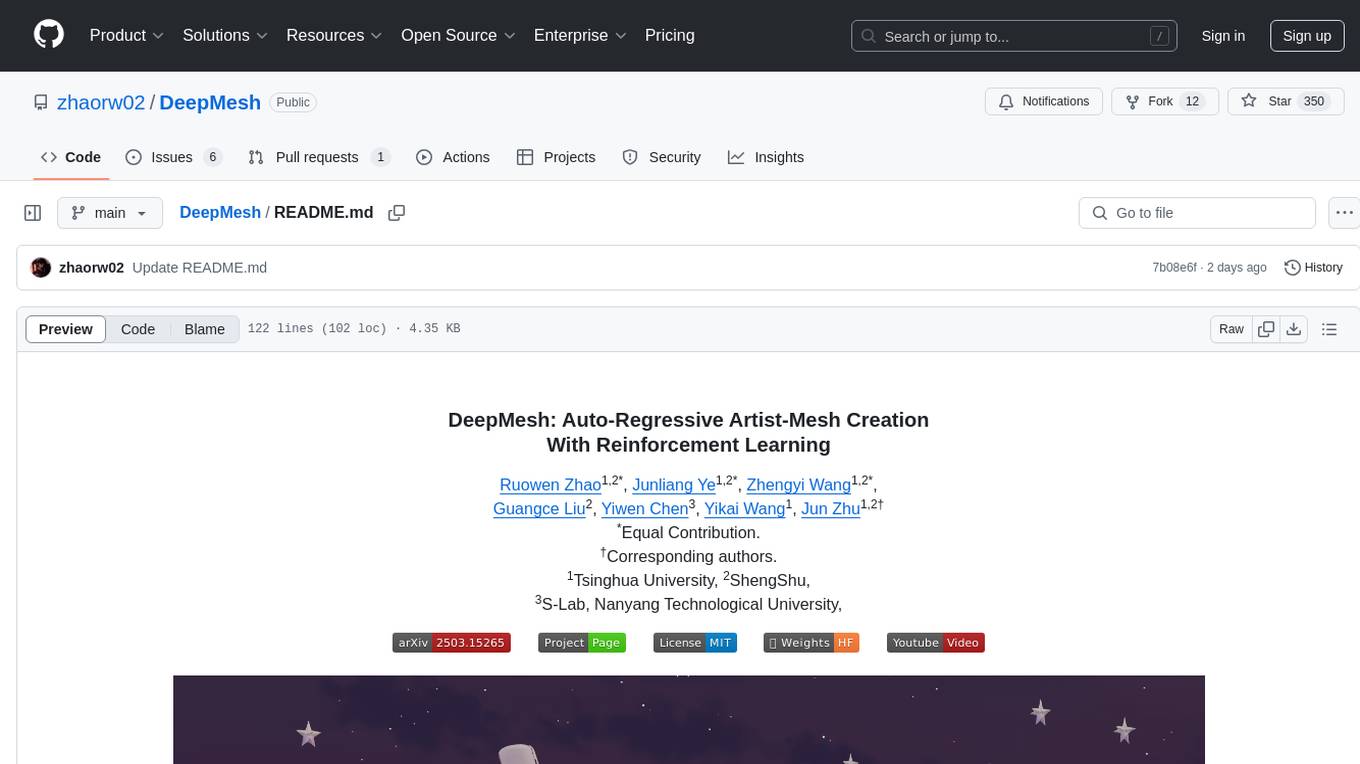
DeepMesh
DeepMesh is an auto-regressive artist-mesh creation tool that utilizes reinforcement learning to generate high-quality meshes conditioned on a given point cloud. It offers pretrained weights and allows users to generate obj/ply files based on specific input parameters. The tool has been tested on Ubuntu 22 with CUDA 11.8 and supports A100, A800, and A6000 GPUs. Users can clone the repository, create a conda environment, install pretrained model weights, and use command line inference to generate meshes.
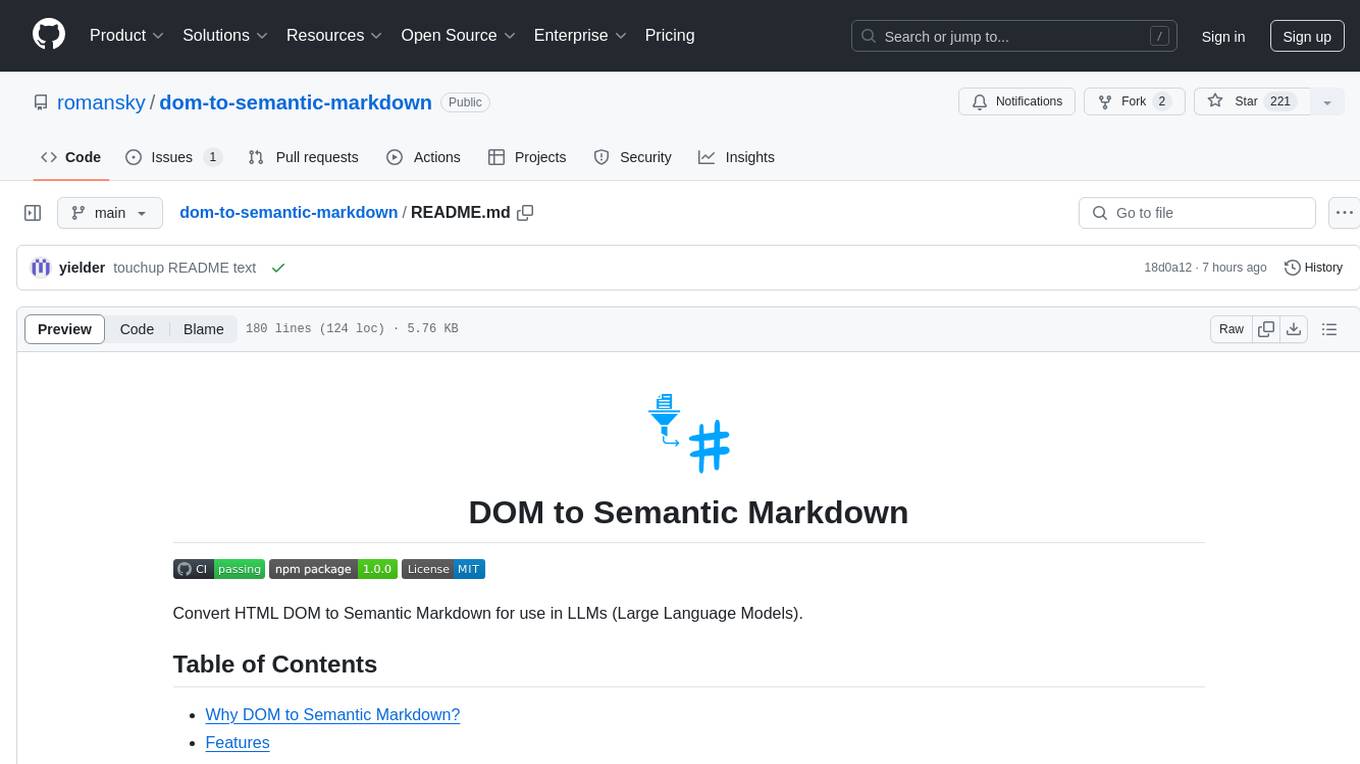
dom-to-semantic-markdown
DOM to Semantic Markdown is a tool that converts HTML DOM to Semantic Markdown for use in Large Language Models (LLMs). It maximizes semantic information, token efficiency, and preserves metadata to enhance LLMs' processing capabilities. The tool captures rich web content structure, including semantic tags, image metadata, table structures, and link destinations. It offers customizable conversion options and supports both browser and Node.js environments.
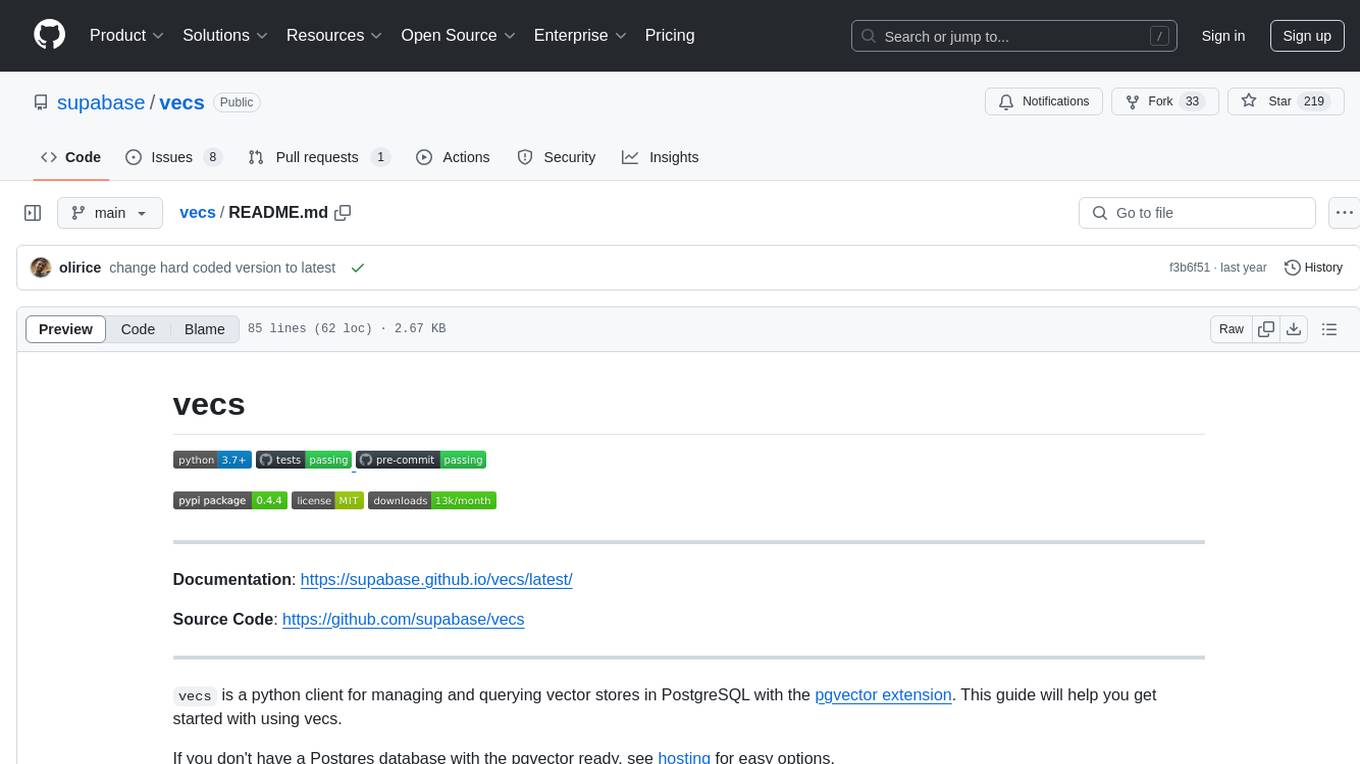
vecs
vecs is a Python client for managing and querying vector stores in PostgreSQL with the pgvector extension. It allows users to create collections of vectors with associated metadata, index the collections for fast search performance, and query the collections based on specified filters. The tool simplifies the process of working with vector data in a PostgreSQL database, making it easier to store, retrieve, and analyze vector information.
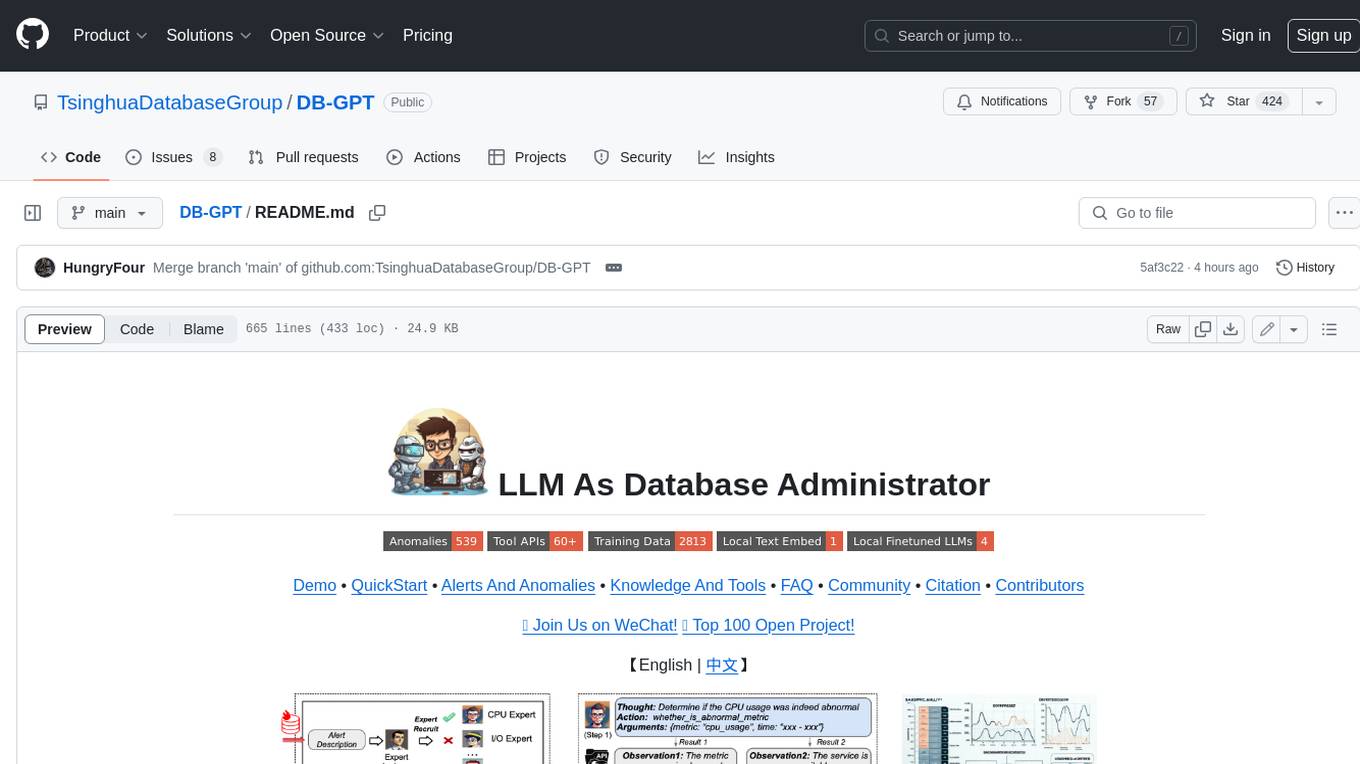
DB-GPT
DB-GPT is a personal database administrator that can solve database problems by reading documents, using various tools, and writing analysis reports. It is currently undergoing an upgrade. **Features:** * **Online Demo:** * Import documents into the knowledge base * Utilize the knowledge base for well-founded Q&A and diagnosis analysis of abnormal alarms * Send feedbacks to refine the intermediate diagnosis results * Edit the diagnosis result * Browse all historical diagnosis results, used metrics, and detailed diagnosis processes * **Language Support:** * English (default) * Chinese (add "language: zh" in config.yaml) * **New Frontend:** * Knowledgebase + Chat Q&A + Diagnosis + Report Replay * **Extreme Speed Version for localized llms:** * 4-bit quantized LLM (reducing inference time by 1/3) * vllm for fast inference (qwen) * Tiny LLM * **Multi-path extraction of document knowledge:** * Vector database (ChromaDB) * RESTful Search Engine (Elasticsearch) * **Expert prompt generation using document knowledge** * **Upgrade the LLM-based diagnosis mechanism:** * Task Dispatching -> Concurrent Diagnosis -> Cross Review -> Report Generation * Synchronous Concurrency Mechanism during LLM inference * **Support monitoring and optimization tools in multiple levels:** * Monitoring metrics (Prometheus) * Flame graph in code level * Diagnosis knowledge retrieval (dbmind) * Logical query transformations (Calcite) * Index optimization algorithms (for PostgreSQL) * Physical operator hints (for PostgreSQL) * Backup and Point-in-time Recovery (Pigsty) * **Continuously updated papers and experimental reports** This project is constantly evolving with new features. Don't forget to star ⭐ and watch 👀 to stay up to date.
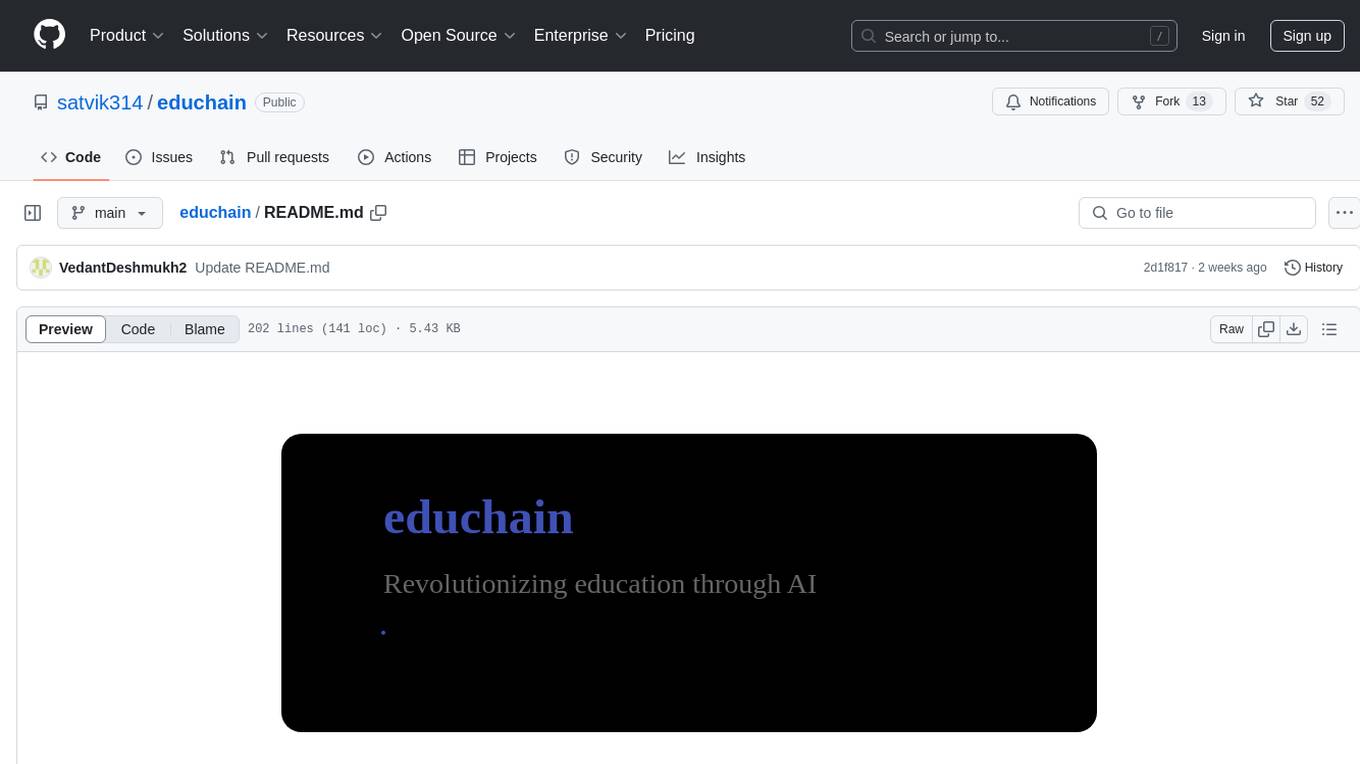
educhain
Educhain is a powerful Python package that leverages Generative AI to create engaging and personalized educational content. It enables users to generate multiple-choice questions, create lesson plans, and support various LLM models. Users can export questions to JSON, PDF, and CSV formats, customize prompt templates, and generate questions from text, PDF, URL files, youtube videos, and images. Educhain outperforms traditional methods in content generation speed and quality. It offers advanced configuration options and has a roadmap for future enhancements, including integration with popular Learning Management Systems and a mobile app for content generation on-the-go.
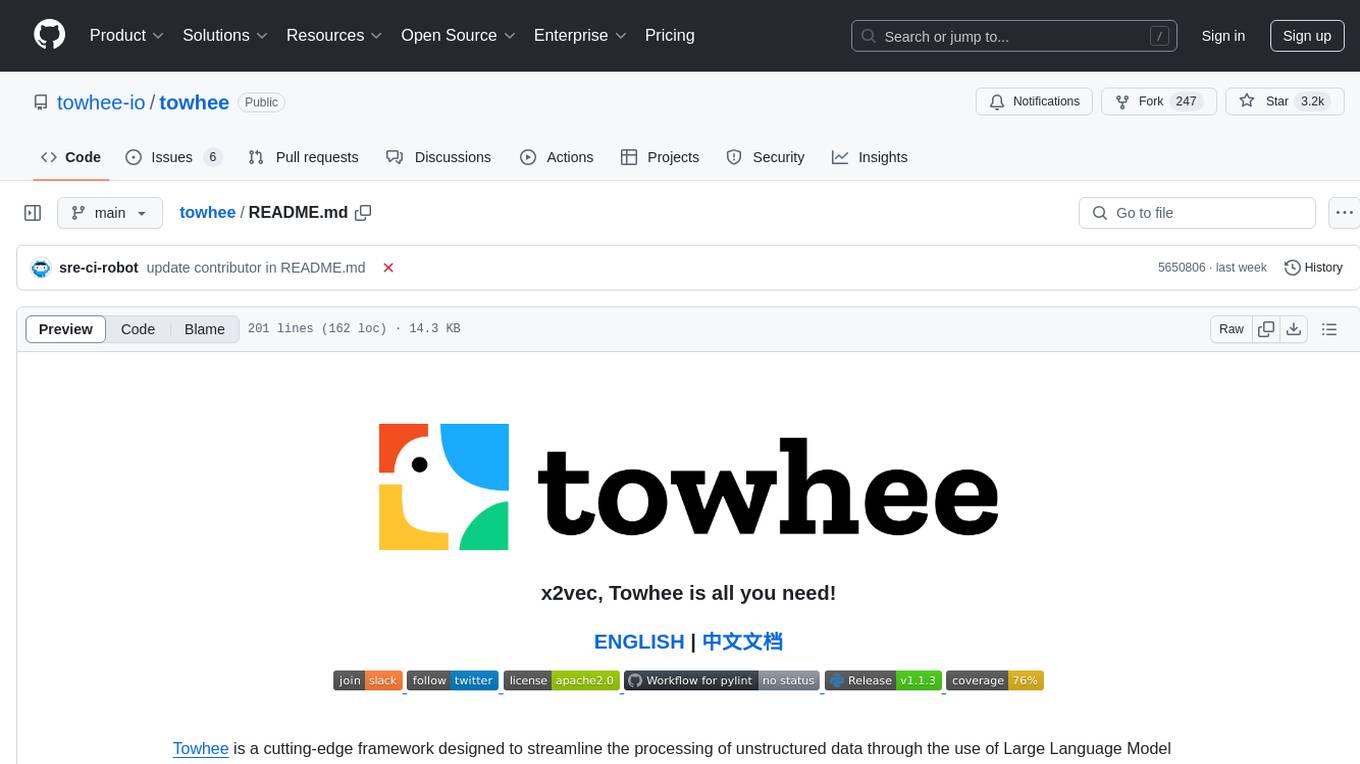
towhee
Towhee is a cutting-edge framework designed to streamline the processing of unstructured data through the use of Large Language Model (LLM) based pipeline orchestration. It can extract insights from diverse data types like text, images, audio, and video files using generative AI and deep learning models. Towhee offers rich operators, prebuilt ETL pipelines, and a high-performance backend for efficient data processing. With a Pythonic API, users can build custom data processing pipelines easily. Towhee is suitable for tasks like sentence embedding, image embedding, video deduplication, question answering with documents, and cross-modal retrieval based on CLIP.
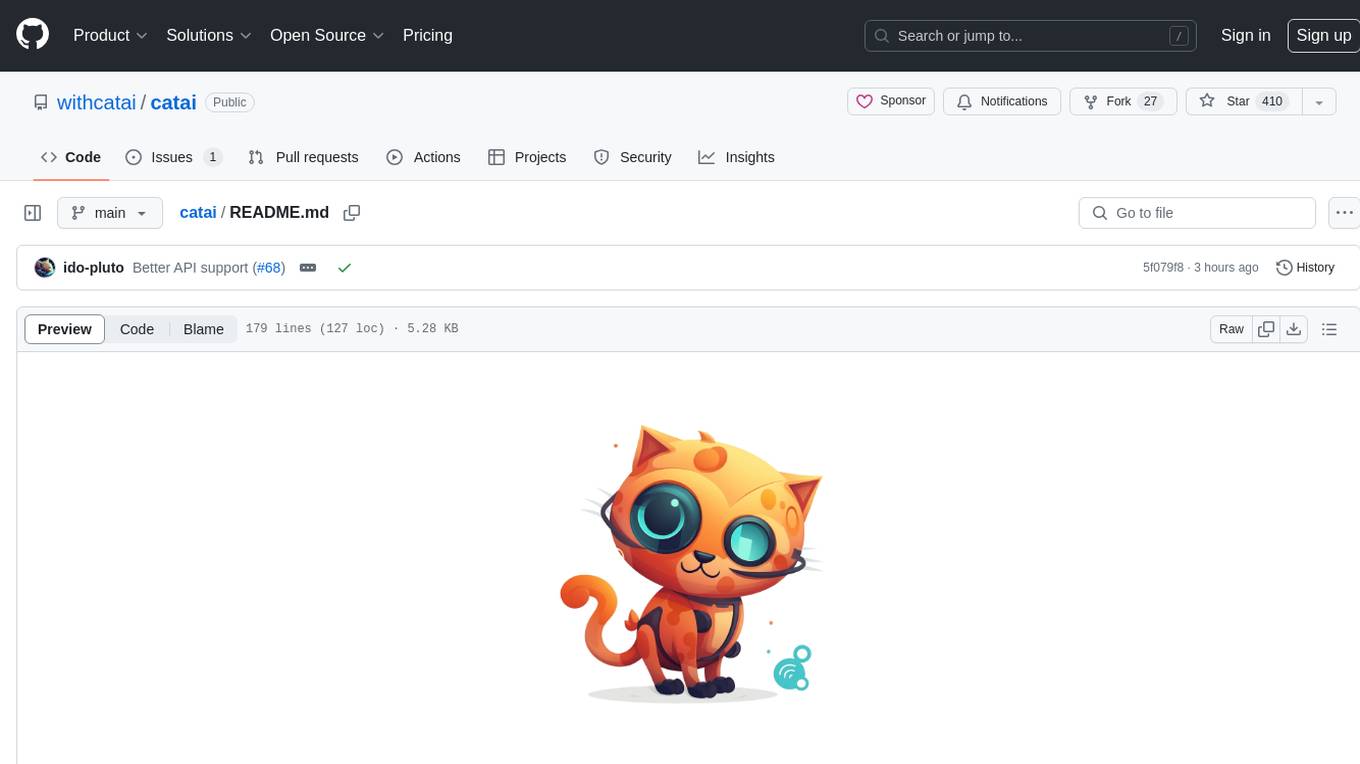
catai
CatAI is a tool that allows users to run GGUF models on their computer with a chat UI. It serves as a local AI assistant inspired by Node-Llama-Cpp and Llama.cpp. The tool provides features such as auto-detecting programming language, showing original messages by clicking on user icons, real-time text streaming, and fast model downloads. Users can interact with the tool through a CLI that supports commands for installing, listing, setting, serving, updating, and removing models. CatAI is cross-platform and supports Windows, Linux, and Mac. It utilizes node-llama-cpp and offers a simple API for asking model questions. Additionally, developers can integrate the tool with node-llama-cpp@beta for model management and chatting. The configuration can be edited via the web UI, and contributions to the project are welcome. The tool is licensed under Llama.cpp's license.
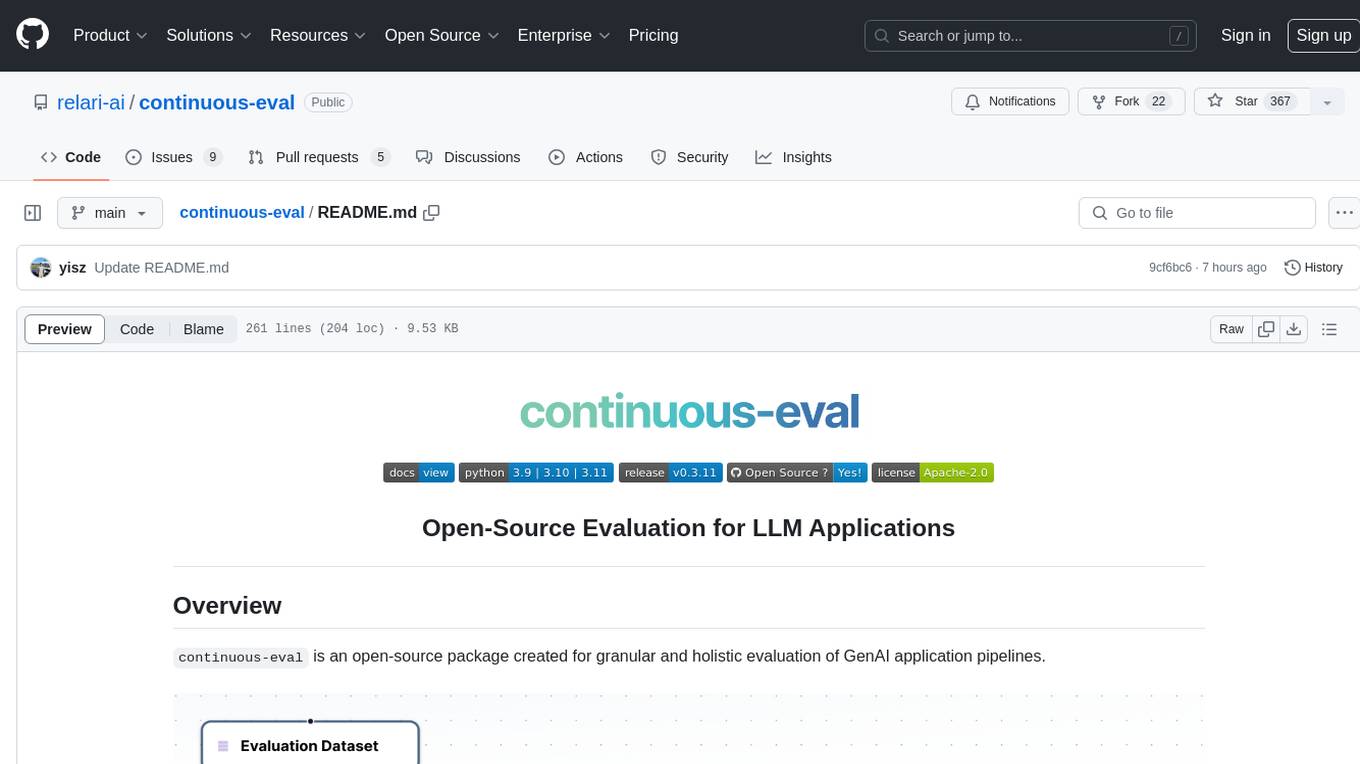
continuous-eval
Open-Source Evaluation for LLM Applications. `continuous-eval` is an open-source package created for granular and holistic evaluation of GenAI application pipelines. It offers modularized evaluation, a comprehensive metric library covering various LLM use cases, the ability to leverage user feedback in evaluation, and synthetic dataset generation for testing pipelines. Users can define their own metrics by extending the Metric class. The tool allows running evaluation on a pipeline defined with modules and corresponding metrics. Additionally, it provides synthetic data generation capabilities to create user interaction data for evaluation or training purposes.
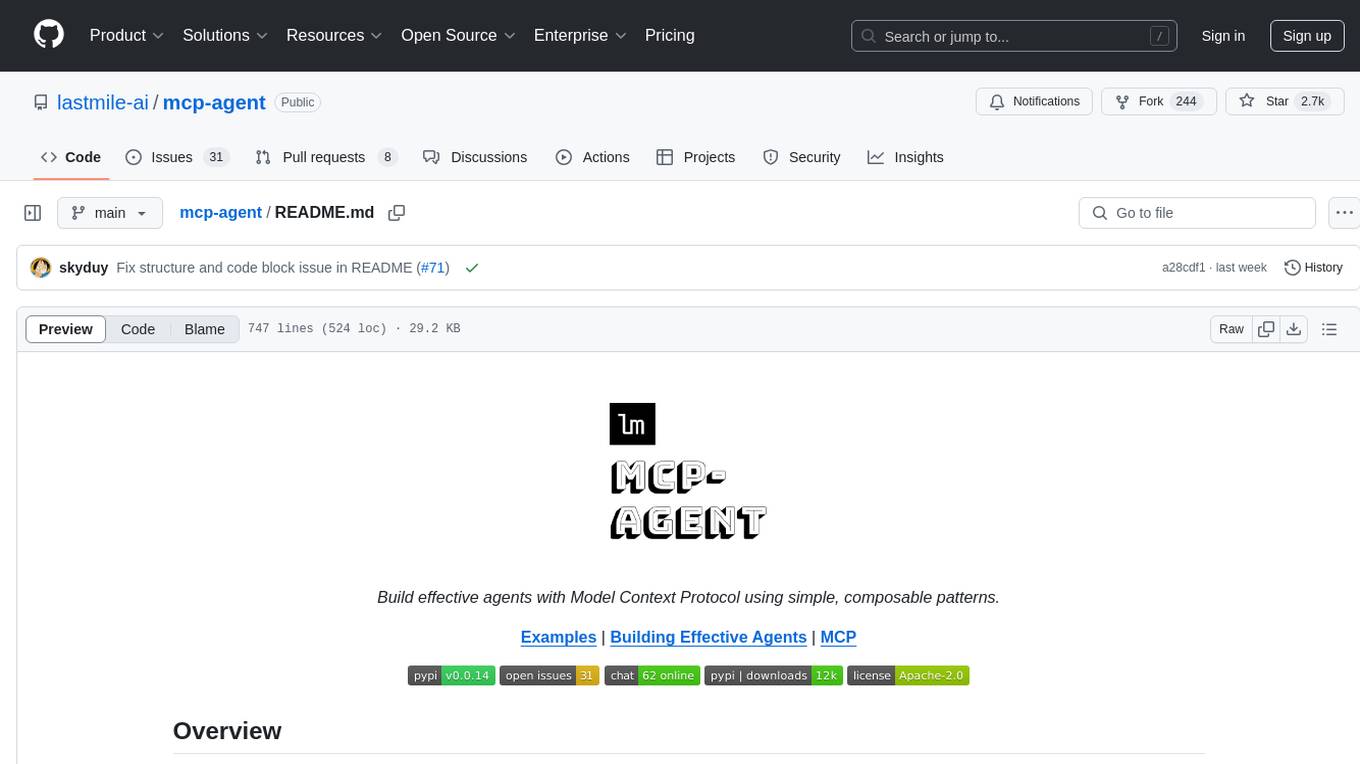
mcp-agent
mcp-agent is a simple, composable framework designed to build agents using the Model Context Protocol. It handles the lifecycle of MCP server connections and implements patterns for building production-ready AI agents in a composable way. The framework also includes OpenAI's Swarm pattern for multi-agent orchestration in a model-agnostic manner, making it the simplest way to build robust agent applications. It is purpose-built for the shared protocol MCP, lightweight, and closer to an agent pattern library than a framework. mcp-agent allows developers to focus on the core business logic of their AI applications by handling mechanics such as server connections, working with LLMs, and supporting external signals like human input.
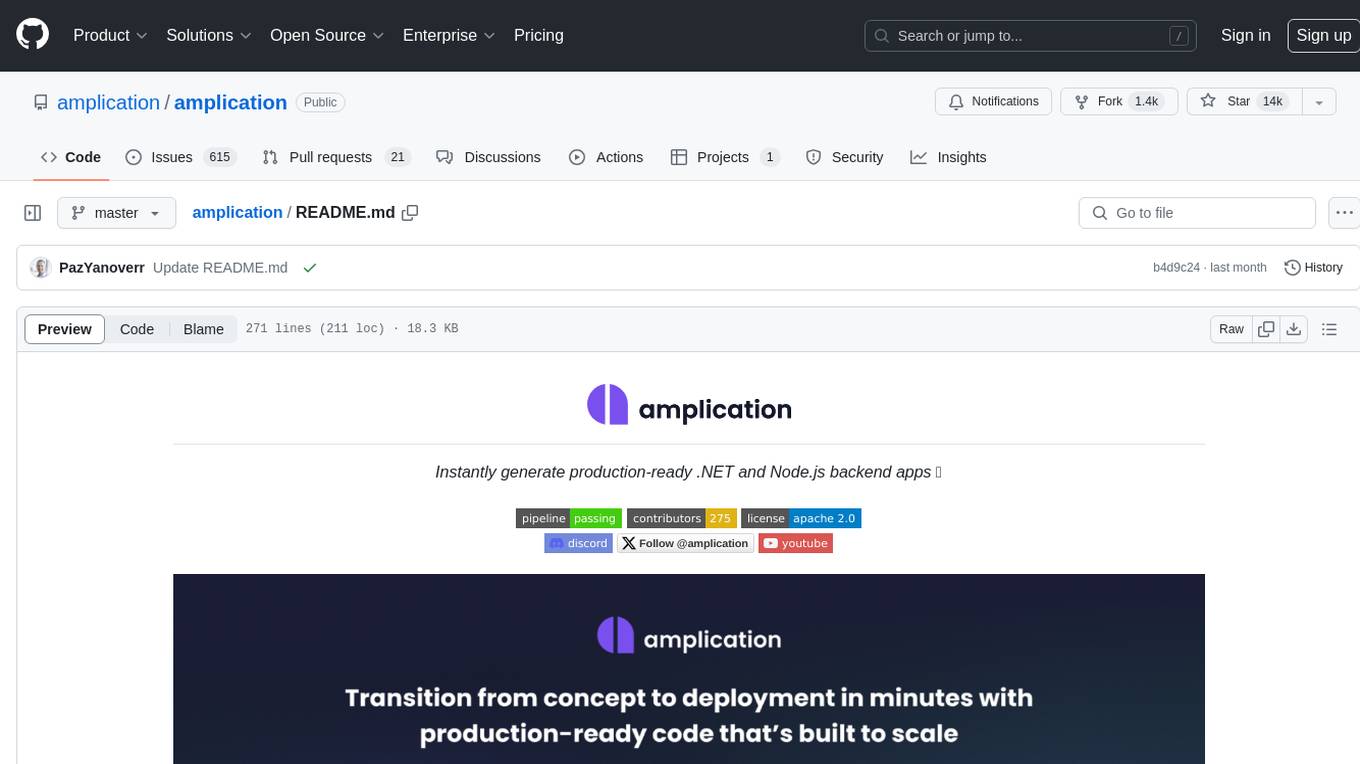
amplication
Amplication is a robust, open-source development platform designed to revolutionize the creation of scalable and secure .NET and Node.js applications. It automates backend applications development, ensuring consistency, predictability, and adherence to the highest standards with code that's built to scale. The user-friendly interface fosters seamless integration of APIs, data models, databases, authentication, and authorization. Built on a flexible, plugin-based architecture, Amplication allows effortless customization of the code and offers a diverse range of integrations. With a strong focus on collaboration, Amplication streamlines team-oriented development, making it an ideal choice for groups of all sizes, from startups to large enterprises. It enables users to concentrate on business logic while handling the heavy lifting of development. Experience the fastest way to develop .NET and Node.js applications with Amplication.
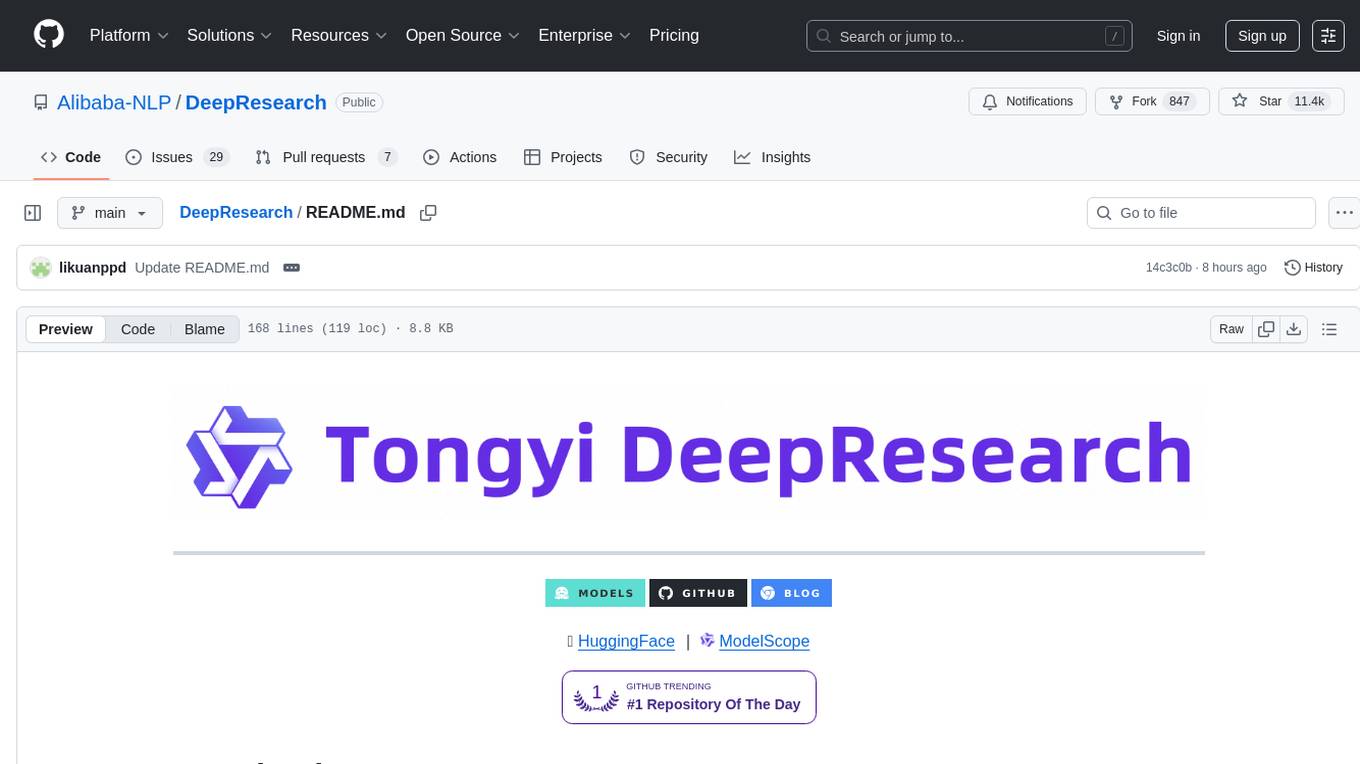
DeepResearch
Tongyi DeepResearch is an agentic large language model with 30.5 billion total parameters, designed for long-horizon, deep information-seeking tasks. It demonstrates state-of-the-art performance across various search benchmarks. The model features a fully automated synthetic data generation pipeline, large-scale continual pre-training on agentic data, end-to-end reinforcement learning, and compatibility with two inference paradigms. Users can download the model directly from HuggingFace or ModelScope. The repository also provides benchmark evaluation scripts and information on the Deep Research Agent Family.
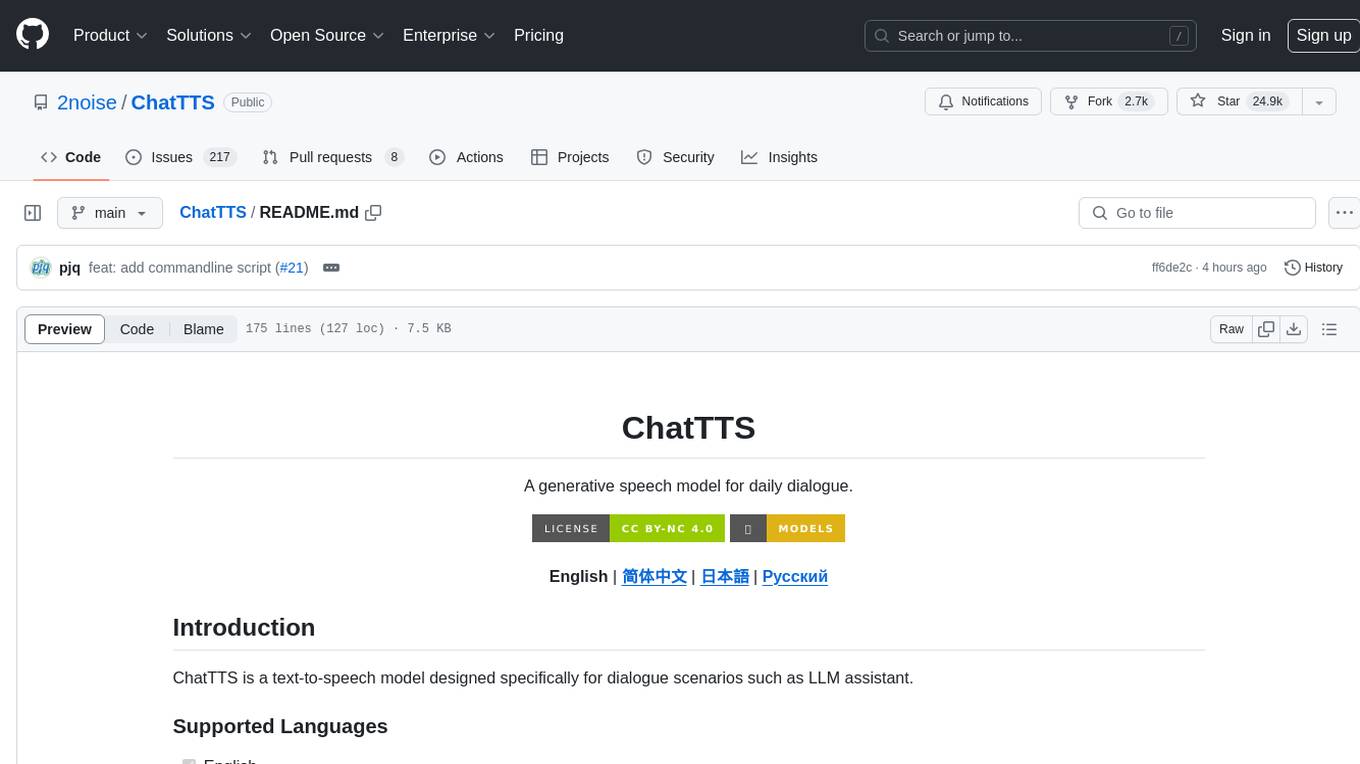
ChatTTS
ChatTTS is a generative speech model optimized for dialogue scenarios, providing natural and expressive speech synthesis with fine-grained control over prosodic features. It supports multiple speakers and surpasses most open-source TTS models in terms of prosody. The model is trained with 100,000+ hours of Chinese and English audio data, and the open-source version on HuggingFace is a 40,000-hour pre-trained model without SFT. The roadmap includes open-sourcing additional features like VQ encoder, multi-emotion control, and streaming audio generation. The tool is intended for academic and research use only, with precautions taken to limit potential misuse.
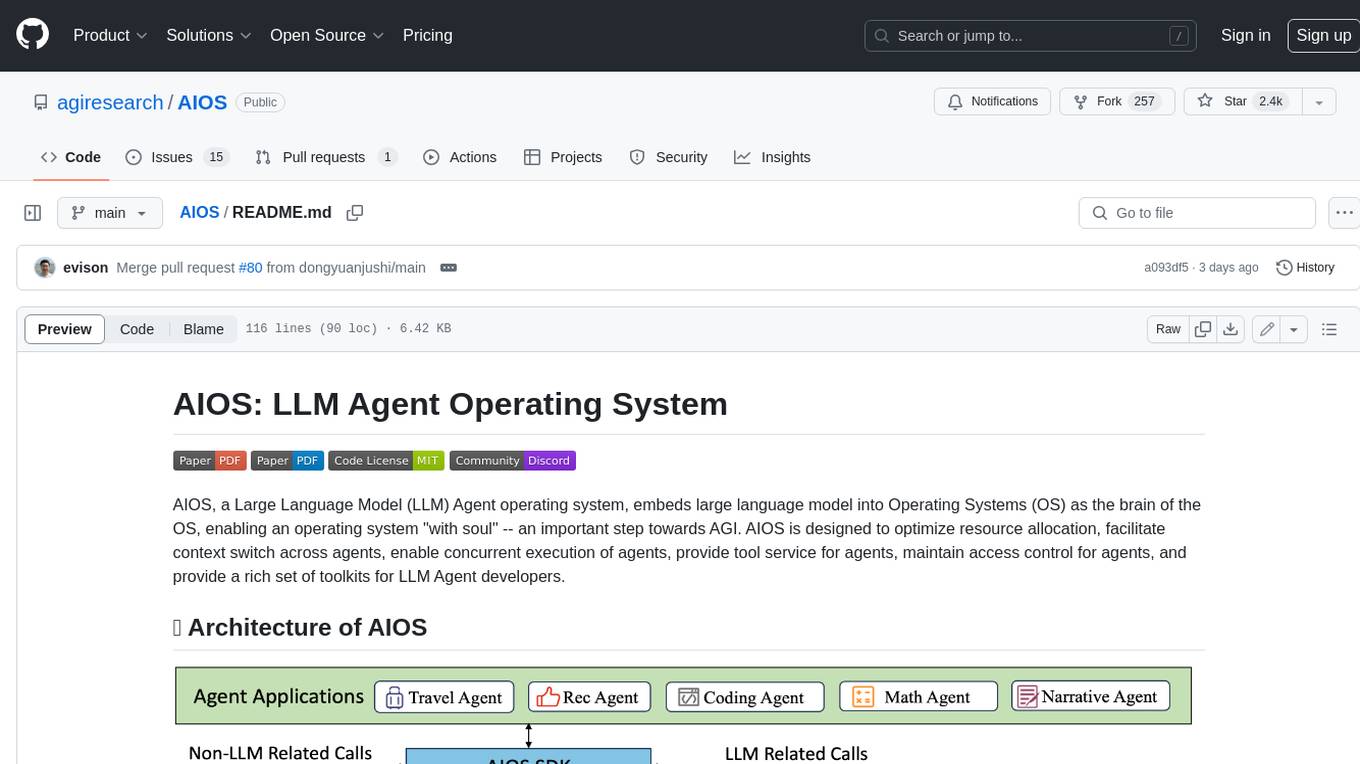
AIOS
AIOS, a Large Language Model (LLM) Agent operating system, embeds large language model into Operating Systems (OS) as the brain of the OS, enabling an operating system "with soul" -- an important step towards AGI. AIOS is designed to optimize resource allocation, facilitate context switch across agents, enable concurrent execution of agents, provide tool service for agents, maintain access control for agents, and provide a rich set of toolkits for LLM Agent developers.
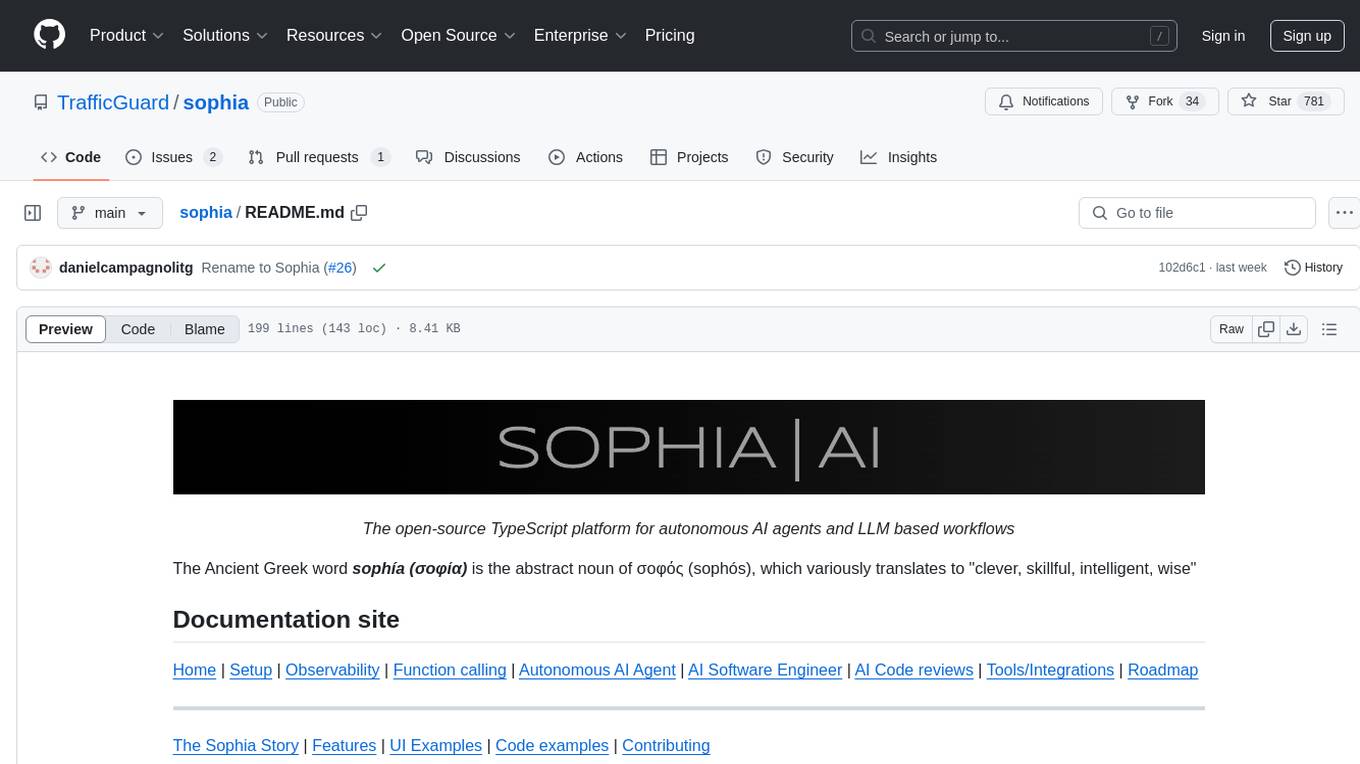
sophia
Sophia is an open-source TypeScript platform designed for autonomous AI agents and LLM based workflows. It aims to automate processes, review code, assist with refactorings, and support various integrations. The platform offers features like advanced autonomous agents, reasoning/planning inspired by Google's Self-Discover paper, memory and function call history, adaptive iterative planning, and more. Sophia supports multiple LLMs/services, CLI and web interface, human-in-the-loop interactions, flexible deployment options, observability with OpenTelemetry tracing, and specific agents for code editing, software engineering, and code review. It provides a flexible platform for the TypeScript community to expand and support various use cases and integrations.
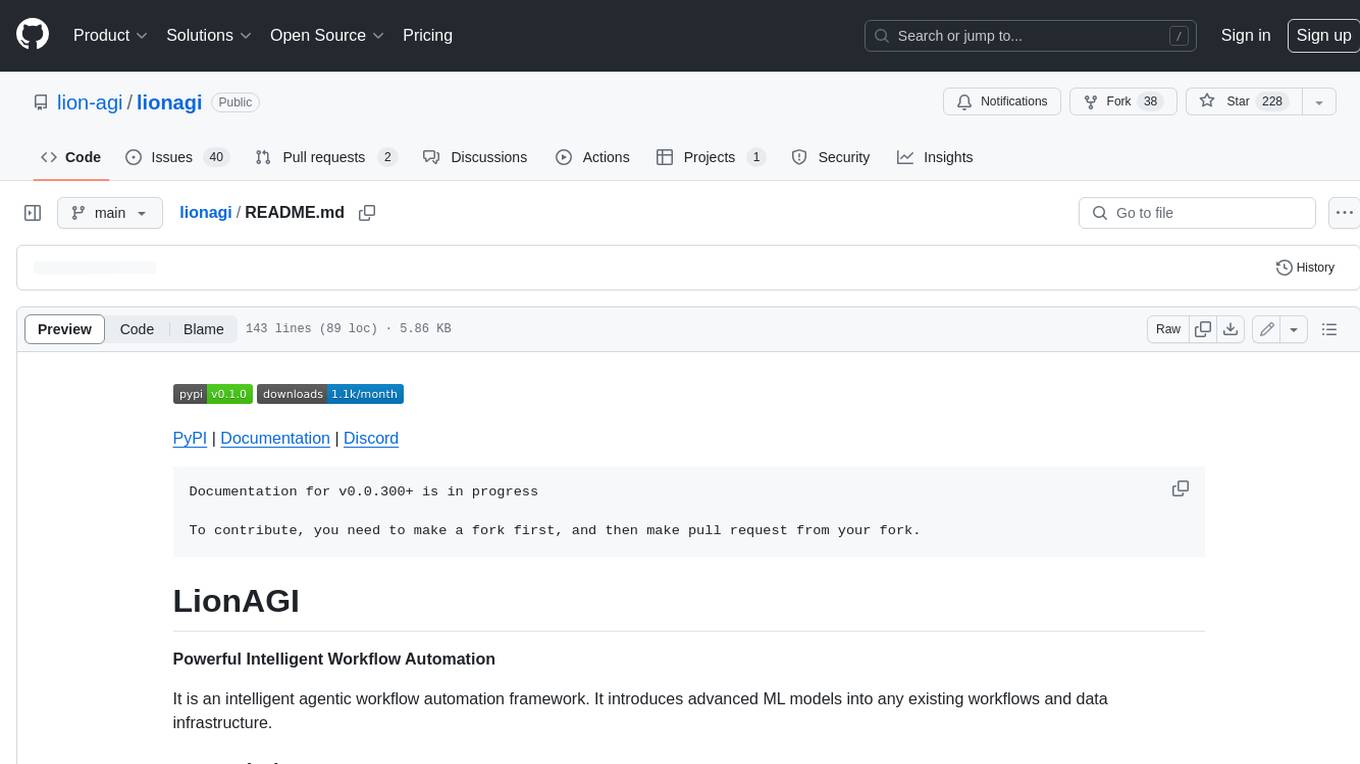
lionagi
LionAGI is a powerful intelligent workflow automation framework that introduces advanced ML models into any existing workflows and data infrastructure. It can interact with almost any model, run interactions in parallel for most models, produce structured pydantic outputs with flexible usage, automate workflow via graph based agents, use advanced prompting techniques, and more. LionAGI aims to provide a centralized agent-managed framework for "ML-powered tools coordination" and to dramatically lower the barrier of entries for creating use-case/domain specific tools. It is designed to be asynchronous only and requires Python 3.10 or higher.
For similar tasks

LLMRec
LLMRec is a PyTorch implementation for the WSDM 2024 paper 'Large Language Models with Graph Augmentation for Recommendation'. It is a novel framework that enhances recommenders by applying LLM-based graph augmentation strategies to recommendation systems. The tool aims to make the most of content within online platforms to augment interaction graphs by reinforcing u-i interactive edges, enhancing item node attributes, and conducting user node profiling from a natural language perspective.
For similar jobs

sweep
Sweep is an AI junior developer that turns bugs and feature requests into code changes. It automatically handles developer experience improvements like adding type hints and improving test coverage.

teams-ai
The Teams AI Library is a software development kit (SDK) that helps developers create bots that can interact with Teams and Microsoft 365 applications. It is built on top of the Bot Framework SDK and simplifies the process of developing bots that interact with Teams' artificial intelligence capabilities. The SDK is available for JavaScript/TypeScript, .NET, and Python.

ai-guide
This guide is dedicated to Large Language Models (LLMs) that you can run on your home computer. It assumes your PC is a lower-end, non-gaming setup.

classifai
Supercharge WordPress Content Workflows and Engagement with Artificial Intelligence. Tap into leading cloud-based services like OpenAI, Microsoft Azure AI, Google Gemini and IBM Watson to augment your WordPress-powered websites. Publish content faster while improving SEO performance and increasing audience engagement. ClassifAI integrates Artificial Intelligence and Machine Learning technologies to lighten your workload and eliminate tedious tasks, giving you more time to create original content that matters.

chatbot-ui
Chatbot UI is an open-source AI chat app that allows users to create and deploy their own AI chatbots. It is easy to use and can be customized to fit any need. Chatbot UI is perfect for businesses, developers, and anyone who wants to create a chatbot.

BricksLLM
BricksLLM is a cloud native AI gateway written in Go. Currently, it provides native support for OpenAI, Anthropic, Azure OpenAI and vLLM. BricksLLM aims to provide enterprise level infrastructure that can power any LLM production use cases. Here are some use cases for BricksLLM: * Set LLM usage limits for users on different pricing tiers * Track LLM usage on a per user and per organization basis * Block or redact requests containing PIIs * Improve LLM reliability with failovers, retries and caching * Distribute API keys with rate limits and cost limits for internal development/production use cases * Distribute API keys with rate limits and cost limits for students

uAgents
uAgents is a Python library developed by Fetch.ai that allows for the creation of autonomous AI agents. These agents can perform various tasks on a schedule or take action on various events. uAgents are easy to create and manage, and they are connected to a fast-growing network of other uAgents. They are also secure, with cryptographically secured messages and wallets.

griptape
Griptape is a modular Python framework for building AI-powered applications that securely connect to your enterprise data and APIs. It offers developers the ability to maintain control and flexibility at every step. Griptape's core components include Structures (Agents, Pipelines, and Workflows), Tasks, Tools, Memory (Conversation Memory, Task Memory, and Meta Memory), Drivers (Prompt and Embedding Drivers, Vector Store Drivers, Image Generation Drivers, Image Query Drivers, SQL Drivers, Web Scraper Drivers, and Conversation Memory Drivers), Engines (Query Engines, Extraction Engines, Summary Engines, Image Generation Engines, and Image Query Engines), and additional components (Rulesets, Loaders, Artifacts, Chunkers, and Tokenizers). Griptape enables developers to create AI-powered applications with ease and efficiency.












